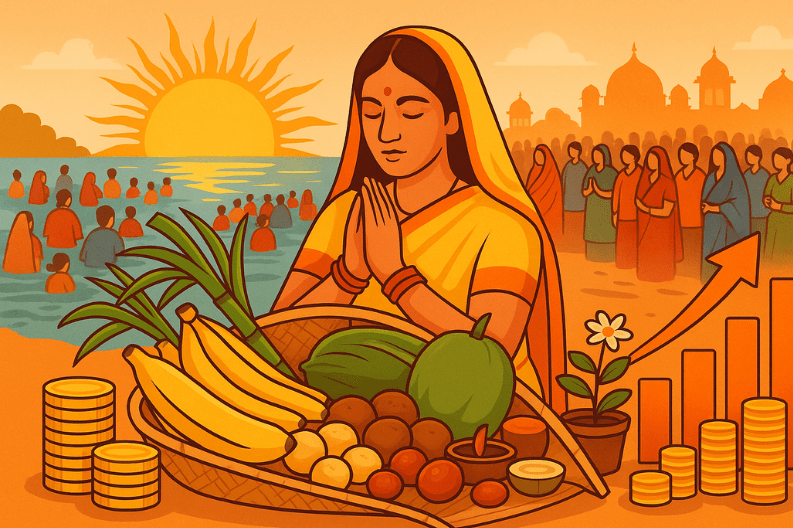The Chhath Puja brings economic boom worth over ₹50,000 crore across India this year. It marks one of the biggest boosts to trade during any festival season. According to the Confederation of All India Traders (CAIT), the festival not only strengthened cultural bonds but also created major economic activity in several states. Celebrated on October 28, this year’s Chhath Puja saw more than 10 crore participants. It became both a cultural and financial highlight of the year.
Large crowds gathered at rivers, lakes, and ponds to offer prayers to the Sun God and other deities. The celebrations were most vibrant in Bihar, Jharkhand, and Uttar Pradesh. Bihar led the economic surge, generating about ₹15,000 crore in trade. Delhi followed with ₹8,000 crore, while Jharkhand added around ₹5,000 crore. These figures show how festivals like Chhath strongly influence India’s economy.
Praveen Khandelwal, Secretary General of CAIT and Member of Parliament, said that Chhath Puja plays a key role in driving local trade. The festival is most popular in Bihar, Jharkhand, and eastern Uttar Pradesh’s Purvanchal region. In Delhi, the large Purvanchali community celebrated enthusiastically, boosting business across local markets.
To support the celebrations, the Delhi government built nearly 1,500 ghats this year. These are special steps leading to water bodies for rituals. The administration also improved roads, lighting, cleanliness, and safety around these sites. These efforts helped create jobs and improved public facilities at the same time.
Other states like West Bengal, Madhya Pradesh, Maharashtra, and Rajasthan also reported high trade activity. Even southern states such as Karnataka, Odisha, and Telangana saw more sales due to migrant communities. This spread shows how Chhath has become a festival celebrated across India, not just in the north.
CAIT’s report listed several top-selling items during the festival. Bananas, sugarcane, coconuts, rice, and grains saw massive demand. Sweets like thekua and laddoos, along with baskets, diyas, flowers, and clay pots, also sold in large numbers. Many small vendors, potters, and bamboo craftsmen saw their income double compared to last year.
There was also a jump in demand for services connected to the ghats. Workers were hired for cleaning and lighting, while boatmen offered rides for rituals. Hotels, transport providers, and flower sellers benefited from the increased footfall. This proves that festivals like Chhath create earnings for both small traders and large businesses.
Khandelwal noted that Prime Minister Narendra Modi’s call to promote Swadeshi (local) products added to the growth. Many markets held “Swadeshi Chhath” campaigns to promote Indian goods such as bamboo baskets, jaggery, and earthen lamps. This push supported local artisans and strengthened rural industries.
The earlier GST Savings Festival, held before Diwali, also played a role. Its momentum carried into Chhath, boosting consumer confidence and retail spending. Traders believe this upward trend will continue through the rest of the festive season.
Chhath Puja is not just a religious festival. It unites people, supports small businesses, and showcases India’s economic resilience. The participation of millions proves that faith and commerce can grow together when people celebrate with purpose and pride.
In conclusion, the Chhath Puja brings economic boom worth ₹50,000 crore across India. It shows how cultural traditions can also drive development, strengthen communities, and promote local trade while celebrating the nation’s diversity and economic strength.



